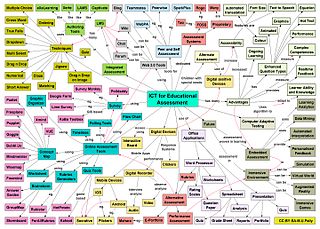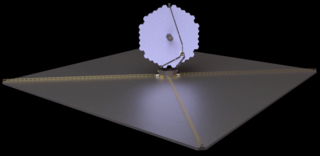Related Research Articles

The European Space Agency is an intergovernmental organisation of 22 member states dedicated to the exploration of space. Established in 1975 and headquartered in Paris, ESA has a worldwide staff of about 2,200, as of 2018, and an annual budget of about €7.08 billion, as of 2023.

Hugo de Garis is an Australian retired researcher in the sub-field of artificial intelligence (AI) known as evolvable hardware. He became known in the 1990s for his research on the use of genetic algorithms to evolve artificial neural networks using three-dimensional cellular automata inside field programmable gate arrays. He claimed that this approach would enable the creation of what he terms "artificial brains" which would quickly surpass human levels of intelligence.

A simulation is the imitation of the operation of a real-world process or system over time. Simulations require the use of models; the model represents the key characteristics or behaviors of the selected system or process, whereas the simulation represents the evolution of the model over time. Often, computers are used to execute the simulation.
The technological singularity—or simply the singularity—is a hypothetical future point in time at which technological growth becomes uncontrollable and irreversible, resulting in unforeseeable changes to human civilization. According to the most popular version of the singularity hypothesis, I. J. Good's intelligence explosion model, an upgradable intelligent agent will eventually enter a "runaway reaction" of self-improvement cycles, each new and more intelligent generation appearing more and more rapidly, causing an "explosion" in intelligence and resulting in a powerful superintelligence that qualitatively far surpasses all human intelligence.

FlightGear Flight Simulator is a free, open source multi-platform flight simulator developed by the FlightGear project since 1997.

The German Aerospace Center is the national center for aerospace, energy and transportation research of Germany, founded in 1969. It is headquartered in Cologne with 35 locations throughout Germany. The DLR is engaged in a wide range of research and development projects in national and international partnerships. DLR also acts as the German space agency and is responsible for planning and implementing the German space programme on behalf of the German federal government. As a project management agency, DLR coordinates and answers the technical and organisational implementation of projects funded by a number of German federal ministries. As of 2020, the German Aerospace Center had a national budget of €1.261 billion.

The Vision for Space Exploration (VSE) was a plan for space exploration announced on January 14, 2004 by President George W. Bush. It was conceived as a response to the Space Shuttle Columbia disaster, the state of human spaceflight at NASA, and as a way to regain public enthusiasm for space exploration.

Information and communications technology (ICT) is an extensional term for information technology (IT) that stresses the role of unified communications and the integration of telecommunications and computers, as well as necessary enterprise software, middleware, storage and audiovisual, that enable users to access, store, transmit, understand and manipulate information.
The Blue Brain Project is a Swiss brain research initiative that aims to create a digital reconstruction of the mouse brain. The project was founded in May 2005 by the Brain and Mind Institute of École Polytechnique Fédérale de Lausanne (EPFL) in Switzerland. Its mission is to use biologically-detailed digital reconstructions and simulations of the mammalian brain to identify the fundamental principles of brain structure and function.

Copernicus is the Earth observation component of the European Union Space Programme, managed by the European Commission and implemented in partnership with the EU Member States, the European Space Agency (ESA), the European Organisation for the Exploitation of Meteorological Satellites (EUMETSAT), the European Centre for Medium-Range Weather Forecasts (ECMWF), the Joint Research Centre (JRC), the European Environment Agency (EEA), the European Maritime Safety Agency (EMSA), Frontex, SatCen and Mercator Océan.

The idea of sending humans to Mars has been the subject of aerospace engineering and scientific studies since the late 1940s as part of the broader exploration of Mars. Some have also considered exploring the Martian moons of Phobos and Deimos. Long-term proposals have included sending settlers and terraforming the planet. Proposals for human missions to Mars have come from e.g. NASA, European Space Agency, Boeing, and SpaceX. As of 2023, only robotic landers and rovers have been on Mars. The farthest humans have been beyond Earth is the Moon, under the Apollo program.

Quantum technology is an emerging field of physics and engineering, encompassing technologies that rely on the properties of quantum mechanics, especially quantum entanglement, quantum superposition, and quantum tunneling. Quantum computing, sensors, cryptography, simulation, measurement, and imaging are all examples of emerging quantum technologies. The development of quantum technology also heavily impacts established fields such as space exploration.
The Human Brain Project (HBP) is a large ten-year scientific research project, based on exascale supercomputers, that aims to build a collaborative ICT-based scientific research infrastructure to allow researchers across Europe to advance knowledge in the fields of neuroscience, computing, and brain-related medicine.

NASA's large strategic science missions or large strategic missions, formerly known as Flagship missions or Flagship-class missions, are the costliest and most capable NASA science spacecraft. Flagship missions exist within all four divisions of NASA's Science Mission Directorate (SMD): the astrophysics, Earth science, heliophysics and planetary science divisions.

Dirk Helbing is Professor of Computational Social Science at the Department of Humanities, Social and Political Sciences and affiliate of the Computer Science Department at ETH Zurich.

Space research is scientific study carried out in outer space, and by studying outer space. From the use of space technology to the observable universe, space research is a wide research field. Earth science, materials science, biology, medicine, and physics all apply to the space research environment. The term includes scientific payloads at any altitude from deep space to low Earth orbit, extended to include sounding rocket research in the upper atmosphere, and high-altitude balloons.
Adrian (Mihai) Ionescu is a full Professor at the Swiss Federal Institute of Technology in Lausanne (EPFL) on a special contract.
The Graphene Flagship is a European Union scientific research initiative. With a budget of €1 billion, it is one of the large scale initiatives organized by the Future and Emerging Technologies program, along with the Human Brain Project and the Quantum Technologies Flagship. Through a combined academic-industrial consortium, the research effort attempts to develop technologies which range from basic research to production and system integration, using the unique properties of graphene. There are some critics of this and similar initiatives, arguing that the funding of graphene-related research and innovation is disproportional to estimates of industrial potential. However, advocates for the Graphene Flagship note the merits of the initiative’s wide-ranging, applications-focused research, and the potential for graphene to catalyze innovation and economic growth across sectors and interest areas including biomedical research and health, transport, water safety, energy efficiency, battery and semiconductor development, wearable electronics, digital communications, sustainability and the environment, and space exploration.

The Large Ultraviolet Optical Infrared Surveyor, commonly known as LUVOIR, is a multi-wavelength space telescope concept being developed by NASA under the leadership of a Science and Technology Definition Team. It is one of four large astrophysics space mission concepts studied in preparation for the National Academy of Sciences 2020 Astronomy and Astrophysics Decadal Survey.
The European Future and Emerging Technologies (FET) Flagship projects include the Graphene Flagship, Human Brain Project, Battery 2030+, and the Quantum technology Flagship.
References
- ↑ Gareth Morgan (28 December 2010). "Earth project aims to 'simulate everything'". BBC News. Retrieved 28 December 2010.
- ↑ "FutureICT". Archived from the original on 27 January 2011. Retrieved 29 December 2010.
- ↑ Rockel, Nick (May 2012). "Project save the world". Institutional Investor : 21.
- ↑ Alison Abbott & Quirin Schiermeier (29 January 2013). "Research prize boost for Europe". nature .
- Leake, Jonathan (4 December 2011). "'Hitchhiker's Guide' PC to predict crises". The Australian . Retrieved 5 April 2012.
- Leake, Jonathan (5 December 2011). "Scientific bid to trump 'failed' economics". The Australian . Retrieved 5 April 2012.
- Weinberger, David (December 2011). "The Machine That Would Predict the Future". Scientific American. Retrieved 5 April 2012.
- Rudolf, John Collins (3 January 2011). "A 'Planetary Simulator' That Averts Crises". The New York Times . Retrieved 5 April 2012.